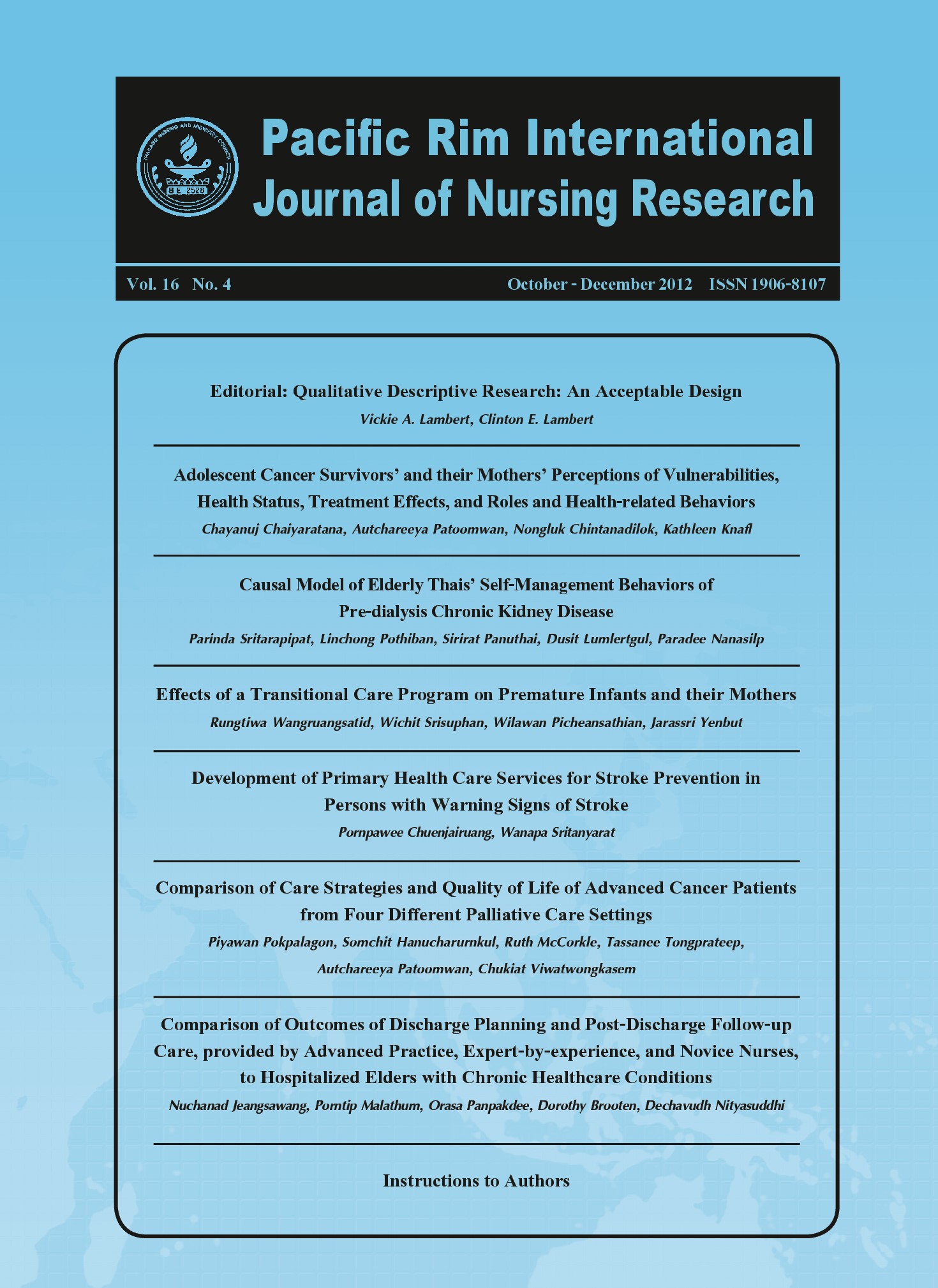Development of Primary Health Care Services for Stroke Prevention in Persons with Warning Signs of Stroke
Keywords:
Stroke, Stroke warning signs, Primary health care services, Participatoryaction researchAbstract
บทคัดย่อ
การวิจัยเชิงปฏิบัติการนี้ มีวัตถุประสงค์เพื่อพัฒนาการบริการสุขภาพปฐมภูมิเพื่อป้องกันโรคหลอดเลือดสมองสำหรับบุคคลที่มีอาการเตือนของโรคหลอดเลือดสมอง ซึ่งทำการศึกษา ณ ศูนย์สุขภาพชุมชนแห่งหนึ่ง ในภาคกลางของประเทศไทย ระหว่างเดือนธันวาคม 2552 – ธันวาคม 2553 การดำเนินการวิจัย แบ่งเป็น 2 ส่วน คือ 1) ส่วนของการวิเคราะห์สถานการณ์ ประกอบด้วย การวิเคราะห์ประเด็นที่ต้องการพัฒนาการบริการสุขภาพเพื่อป้องกันโรคหลอดเลือดสมองสำหรับบุคคลที่มีอาการเตือนของโรคหลอดเลือดสมอง การวิเคราะห์ปัญหาและความต้องการการบริการสุขภาพของ บุคคลที่มีอาการเตือนของโรคหลอดเลือดสมองและครอบครัว และการระบุปัจจัยสำคัญที่เอื้อต่อการพัฒนาการบริการสุขภาพปฐมภูมิสำหรับบุคคลที่มีอาการเตือนของโรคหลอดเลือดสมอง และ 2) ส่วนของกระบวนการพัฒนาฯ ประกอบด้วย 4 ระยะ คือ 1) ระยะสร้างความตระหนักและความต้องการในการพัฒนาบริการ 2) ระยะสร้างความร่วมมือในการพัฒนาบริการ 3) ระยะขยายเครือข่ายการพัฒนา และ 4) ระยะขยายแนวร่วมบริการไปสู่แกนนำภาคประชาชน ผลลัพธ์ของการพัฒนาฯ มีดังนี้ 1) บุคคลที่มีอาการเตือนของโรคหลอดเลือดสมองและครอบครัว เข้าถึงการบริการสุขภาพปฐมภูมิและได้ รับการบริการอย่างต่อเนื่องเป็นองค์รวม และสอดรับกับความต้องการในแต่ละระยะของวิถีการเจ็บป่วย 2) บุคลากรทีมสุขภาพมีทีมเครือข่ายการบริการสุขภาพปฐมภูมิ ทั้งที่เป็นทีมสหสาขาวิชาชีพ ทีมเครือข่ายภาคประชาชน พร้อมทั้งบุคคลที่มีอาการเตือนและครอบครัว และมีการพัฒนาแบบประเมินและแนวปฏิบัติในการจัดบริการ และ 3) องค์กรให้บริการสุขภาพปฐมภูมิ ได้รูปแบบบริการสุขภาพปฐม ภูมิโดยการมีส่วนร่วมของชุมชนสำหรับบุคคลที่มีอาการเตือนของโรคหลอดเลือดสมอง ปัจจัยสำคัญที่เอื้อต่อการพัฒนาบริการสุขภาพปฐมภูมิสำหรับบุคคลที่มีอาการเตือนของโรคหลอดเลือดสมองในศูนย์ สุขภาพชุมชนครั้งนี้ คือ 1) ทัศนะเชิงบวกของบุคลากรสุขภาพต่อสถานการณ์ 2) แนวคิดการบริการที่สอดคล้องกันของบุคลากรทีมสุขภาพ 3) ความร่วมมือของเครือข่ายภาคีหุ้นส่วนในชุมชน 4) นโยบายการพัฒนาบริการสุขภาพ จากผลการศึกษาชี้ให้เห็นว่าความตระหนักและความเข้าใจในอาการ เตือนของโรคหลอดเลือดสมอง ของบุคคลที่มีอาการเตือนของโรคหลอดเลือดสมองและครอบครัว รวมทั้งบุคลากรทีมสุขภาพ และการมีส่วนร่วมของชุมชน ช่วยให้บุคคลที่มีอาการเตือนของโรคหลอดเลือดสมองสามารถจัดการตนเองและเข้าถึงบริการสุขภาพที่มีคุณภาพได้
คำสำคัญ: โรคหลอดเลือดสมอง อาการเตือน การบริการสุขภาพปฐมภูมิ การวิจัยเชิงปฏิบัติการ
Abstract
This participatory action research sought to develop primary health care services for strokeprevention in persons with warning signs of stroke. The study was conducted in a primary care unit incentral Thailand between December 2009 and December 2010.
The research consisted of two major components: situational analysis and developmental process.The situational analysis included: exploration of how health care was being delivered to persons with strokewarning signs; determination of the needs of such individuals and their families; and, identification of keyfactors that would contribute to the development of primary health care services for persons with strokewarning signs. The developmental process included four phases: 1) raising awareness and recognizingthe need for the development of primary stroke prevention care; 2) setting up an approach for mutualdevelopment of stroke health care services to be offered by the primary care unit healthcare team; 3)extending the service network from the primary care unit healthcare team to the community healthcarenetwork; and, 4) extending the healthcare network to community members authorized by the healthcareteam to deliver health care services.
The participatory process resulted in: persons with stroke warning signs, and their families, havingaccess to holistic and continuous care services consistent with their needs during each stage of illness;health care providers providing needed care services via multidisciplinary, community care, teams topersons with stroke warning signs; assessment tools and service provision practice guidelines being developed;and, the primary care unit having a community care service model to use when providing carefor persons with stroke warning signs.
Factors that contributed to the development of the community care services provided at the primarycare unit included the: positive attitude of the health care providers toward the situation; congruence ofthe concepts regarding the services provided by the health care providers; collaboration and networkingamong the stakeholders; and, policies that were developed regarding the provision of needed services.The positive development of the community care service program suggested that the awareness andunderstanding of stroke warning signs among the health care providers, as well as the networking thattook place among the persons with warning signs of a stroke, their families and the community, can helppersons with warning signs of a stroke self-manage and obtain quality health care.
Key Words: Stroke; Stroke warning signs; Primary health care services; Participatoryaction research
Downloads
How to Cite
Issue
Section
License
Copyright: The Pacific Rim International Journal of Nursing Research, Thailand Nursing & Midwifery Council has exclusive rights to publish, reproduce and distribute the manuscript and all contents therein.








.png)



